The Clothes of Hanna Palme
Ph.D. Anna Hedtjärn Wester
Curator at the County museum of Sörmland, Sweden
In the collections of the County museum of Sörmland, Sweden, garments of an interesting and charismatic woman are preserved. Her name was Hanna Palme and she lived between 1861 and 1959. A close reading of the clothes revealed information, not only about their wearer, but also about consumption, use and reuse of clothes more than a hundred years ago.
Content: Introduction / A committed woman / Shopping a hundred years ago / The black evening gown / The Silk house dress / The fashion house of Augusta Lundin / K M Lundberg – a department store in Stockholm / The spare-part dress / Recycling and alterations / References and sources
Introduction

Picture: Dresses and portrait from the Hanna Palme collection.
In the collections of the County Museum of Sörmland, Sweden, you can find clothes from people of different social groups in society, ranging from workers to royalty, and from various historic periods. The oldest garment is from the middle of the 18th century and the most recent one is dated 2012. The greater part however dates back to the period 1880 to 1930. One of the largest individual collections derives from Hanna Palme, grandmother of Olof Palme, the former Swedish prime minister. Since 1899 the Palme family has owned an estate in the county of Sörmland, and when Hanna Palme died in 1959, a large number of her clothes were donated to the County museum.
A committed woman
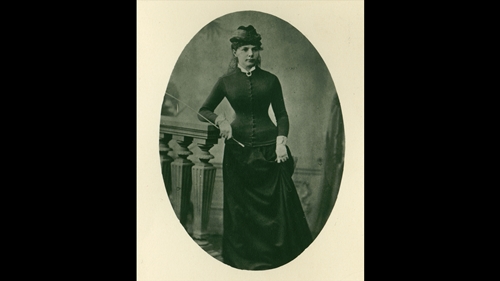
Picture: The young Hanna Palme, circa 1880.
The noble woman Hanna von Born was born in 1861. She grew up on an estate in Finland. Her father was minister of agriculture and he taught her about farming. At the age of 22, she married the Swedish lieutenant Sven Palme and they had four children: Olof, Gunnar, Nils and Birgitta. Gunnar became the father of Olof, who was the Swedish prime minister between 1969 and 1976 and from 1982 until 1986, when he was brutally murdered in Stockholm.

Picture: Hanna Palme´s riding dress, circa 1880.
Hanna Palme became involved in social issues and was an advocate for women´s suffrage and female military service. Fashion for women and children´s wear were other issues in which she engaged. In 1886 she was one of the founders of the Swedish association of dress reform whose purpose was to develop a more comfortable and healthy dress. Hanna herself loved all sorts of sports and it is therefore easy to understand her wish to create a fashion in which it was possible to move more freely. Compared with riding outfits of today Hanna´s riding dress, dated around 1880, looks quite uncomfortable. The skirt was made to fit when riding with a side-saddle, placing both legs on the same side of the horse.
Shopping a hundred years ago

Picture: The mannequin belongs to the Palme family.
In Europe today clothes are cheaper than ever and most of the production takes place in Asia. The Swedish consumption of clothes has increased by 50% over the last 10-15 years and clothes we don´t want or get tired of often end up in the wastebin rather than going to charity or being adjusted to new needs. A hundred years ago, garments were an investment. You could buy readymade clothes but most clothes were made for an individual body, often by a tailor or dressmaker. Clothes were of great value on the secondhand market and you could sell and buy clothes at auctions, in marketplaces and secondhand stores.
Some people had a personal mannequin made up. It did not represent the person´s natural body, but his/her body wearing underwear. It saved time as the customer didn´t have to attend quite as many fittings as otherwise.

Picture: Detail showing a waistband labeled NordiskaKompaniet, a department store in Stockholm.
Most of the clothes in the collection lack labels of any kind and it is therefore not possible to know for sure who made them. It is unlikely that Hanna Palme used different dressmakers every time. A skillful dressmaker, who was familiar with the physique and personal taste of her customer, was highly valued and was, for the customer, someone to hold on to. A few garments in the collection, however, are labeled with names of well-known dressmakers or department stores in Stockholm.
The black evening gown
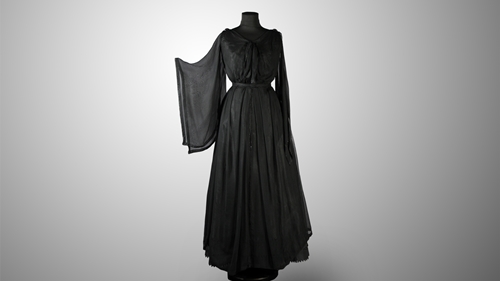
Picture: The black evening gown, 1910.
Some of the garments in the collection are made of parts from other dresses. That is the case with the dress in the picture. The only thing new, apart from the design, is the outermost layer, the black silk chiffon. The silk petticoat originates from a dress of an outdated design. You can see how the dressmaker has adjusted the amount of fabric to a slightly more minimalistic fashion ideal. The lining of the bodice also originates from another dress with more boning. Several seams have been changed and some of the bones have been removed. This kind of recycling does not appear in the dresses with labels. The customer supplied the dressmaker with the fabric, but perhaps used garments were an option only when the relationship between the customer and dressmaker was of a more personal and long lasting nature. The dressmaker showed thriftiness and contrivance when mending and making alterations. The result could still be fashionable as the recycled parts were invisible to the eye when looking at the dressed body.
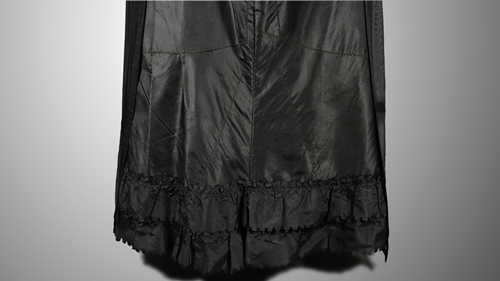
Picture: Detail showing traces of reduction of fabric on the recycled petticoat.
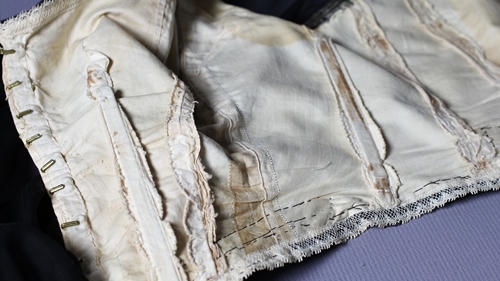
Picture: Detail showing traces of alterations on the lining of the recycled bodice.
The Silk house dress
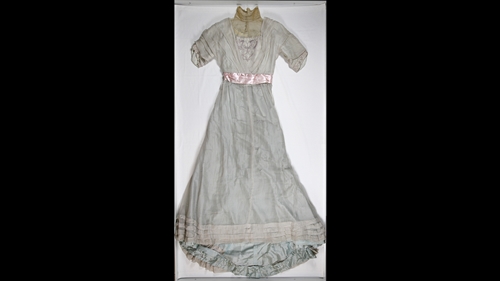
Picture: The Silk house dress, 1910s.
This dress is from the Silk house (Sidenhuset) which was located in Stockholm. At the Silk house you could buy all sorts of silk fabrics and you could also order dresses from their sewing room. Blouses and petticoats could be made up the same day, but commissioned work that required more tailoring, as this dress, took longer. The light blue silk fabric is covered with grey Crêpeline. The dress is severely damaged. At the time producers of silk could add tin chloride to make the fabric heavier as a way to charge a higher price. Apart from having to pay an unfair price for the material, the customer also got a fabric of poor quality. With time the tin chloride ruins the fabric completely, which is what has happened here. The hat is also from the Silk house. Perhaps she bought it to wear with the dress?
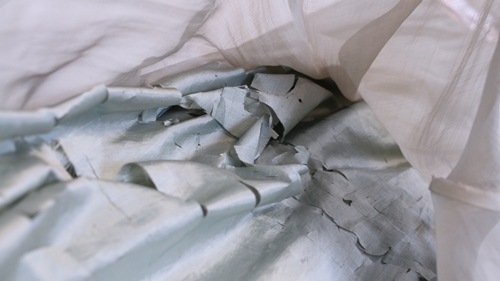
Picture: The silk fabric is in ruins.
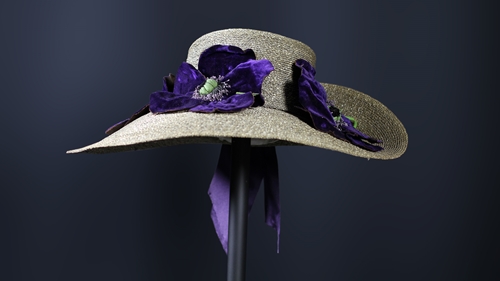
Picture: This hat was also bought at the Silk house.
The fashion house of Augusta Lundin
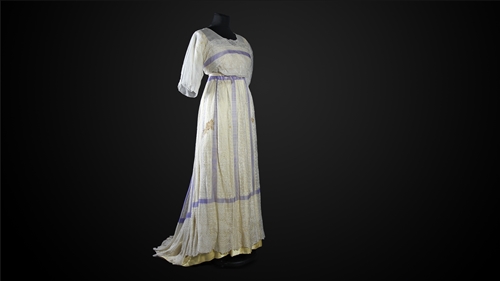
Picture: Dress from the fashion house of Augusta Lundin, 1910s.
This dress was made for Hanna Palme by the most distinguished fashion house for haute couture in Stockholm at the time, Augusta Lundin. Augusta Lundin had licenses to produce dresses after patterns from French fashion houses. She was not a designer in the sense we mean today, but when it came to choice of model, material, fabric and details her exquisite taste was highly valued. Her trademark represented the latest fashion and high quality.
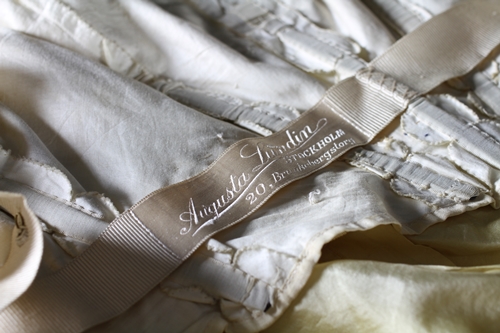
Picture: Detail showing the waistband labeled Augusta Lundin.
K M Lundberg – a department store in Stockholm
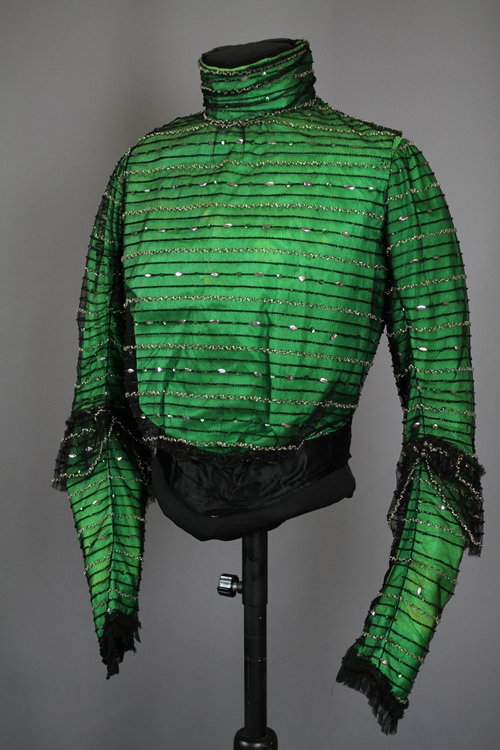
Picture: The green bodice has an outermost layer of bobbin-net decorated with coral beads, circa 1900.
This green bodice was bought at K M Lundberg, the first department store in Stockholm which opened in 1898. At the department store the customer could walk around freely without obligation to purchase and just look at all the fashionable goods which were exposed in a new way. The department stores marketed a wide range of goods at fixed prices, ranging from furniture to clothing. You could buy readymade clothes, or turn to the firm’s sewing room and order a dress that suited your own taste and measurements. The green bodice belongs to the latter category. The skirt matching the bodice is missing. Skirts consisted of a great amount of fabric, which often found other uses over the years. Left for conservation in the museum archives are sometimes merely the bodices.
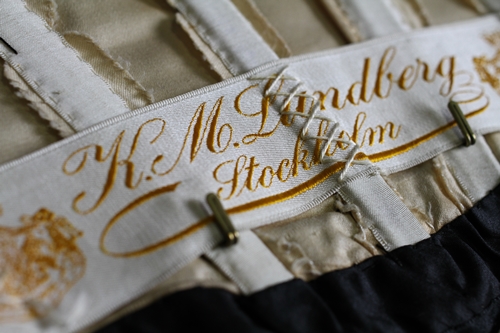
Picture: Detail showing the waistband labeled K M Lundberg.
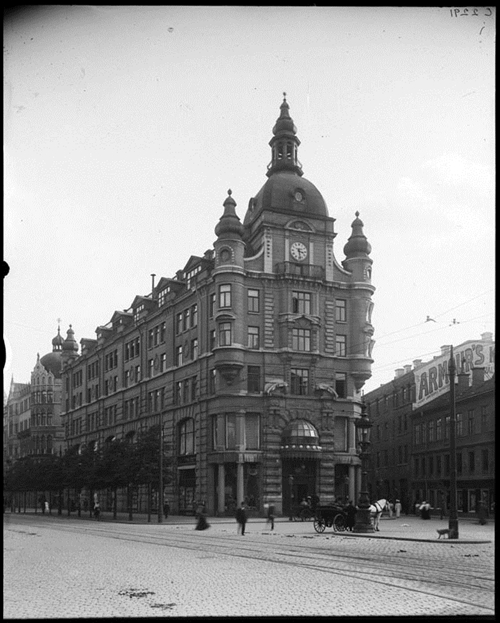
Picture: K M Lundberg, the first department store in Stockholm
The spare-part dress
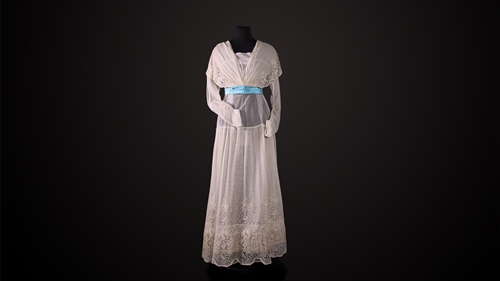
Picture: The bobbin-net dress lacks lining.
This dress of bobbin-net is an illustration of a garment´s lifecycle. The lining has been removed, perhaps to be used in another dress or for some entirely different purpose. Because of the transparency of the fabric the dress was not wearable in this condition. However, the outer layer of bobbin-net has been saved for coming needs.

Picture: Detail of decorative blue silk ribbon.
Recycling and alterations
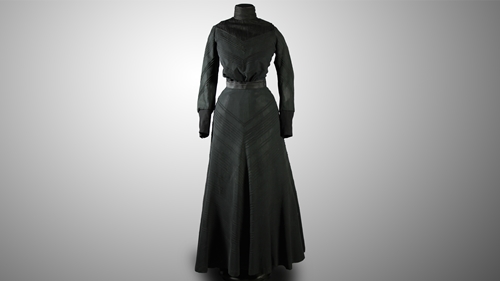
Picture: Dress of black woolen cloth, 1900-1910.
The petticoat belonging to this black dress is made of several remnants of silk fabric. The old cuffs have been replaced for new ones and it has been meticulously mended at the skirt section. 81% of all the garments in the collection of Hanna Palme show traces of alterations, mending and/or recycling. It is a thought-provoking fact. What would be the equivalent percentage of an average wardrobe in Sweden today? In her time, Hanna Palme was not unique in this regard. Well into the 1900s, textile was considered an investment within all social groups. Today, clothes are cheaper than ever, and most people prefer to buy new garments instead of mending or altering the old ones.
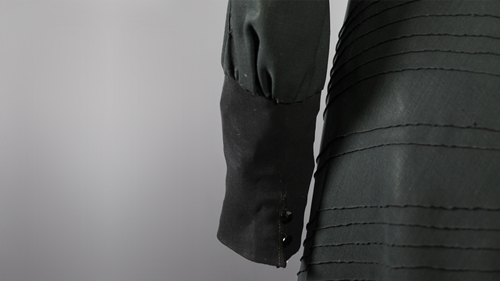
Picture: Detail showing the new cuffs.
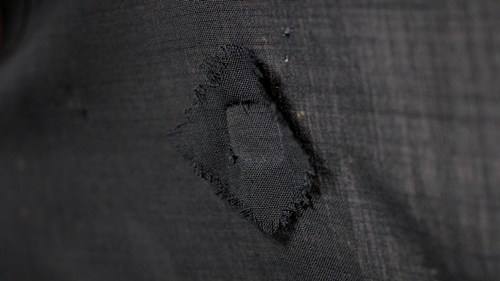
Picture: Detail showing meticulous mending at skirt section.
References and sources
Archival sources
The Hanna Palme collection of garments and photographs at the County museum of Sörmland, Sweden.(Link address: www.sormlandsmuseum.se/hanna-palme ; www.sormlandsmuseum.se/hanna-palme-foto)
Stockholmskällanis an online database where you can find photographs and archive material from Swedish museum collections. Among them the picture of the department store K M Lundberg, City museum of Stockholm. (Link address: www.stockholmskallan.se/Soksida/Post/)
Printed works
Birgitta Wistrand, ”’Ständigt var man i farten att grunda och stifta!’” in Näringslivshistoria; 2, Kvinnors företagande – den verkliga framtidshistorien (Bromma: Centrum för Närlingslivshistoria, 2009) pp.93-122.
Den kvinnliga klädedräkten. Illustrerad beskrivning (Stockholm: Dräktreformföreningen, 1898).
Elisabeth Stavenow, ”Skridskosport i 1880-talets Stockholm” in Fataburen (Stockholm: Nordiska museet, 1960) pp. 242-246.
Henrik Berggren, Underbara dagar framför oss. En biografi över Olof Palme (Stockholm: Norstedts, 2010).
Idun. Praktisk veckotidning för kvinnan och hemmet, No 16, (Stockholm: Iduns Tryckeri Aktiebolag, 1896).
Ingrid Bergman, Kvinnokläder – kvinnokamp, (Stockholm: Nordiska museet, 1986).
OrsiHusz, Drömmars värde. Varuhus och lotteri i svensk konsumtionskultur 1897-1939 (Hedemora: Gidlunds förlag, 2004).
Valerie Steele, ”A museum of fashion is more than a clothes-bag” in Fashion Theory: the journal of dress, body & culture, vol 2, issue 4 (Oxford: Berg Publishers, 1998) pp.327-336.